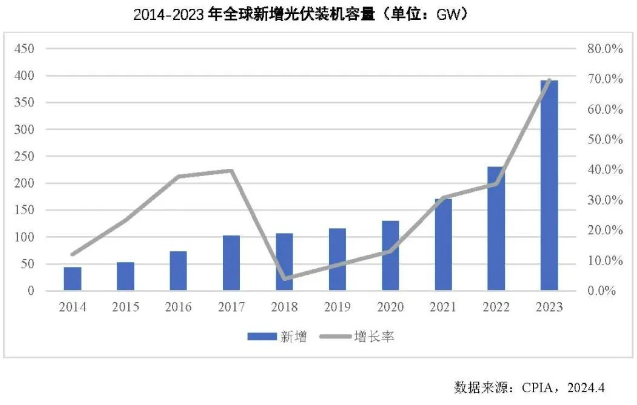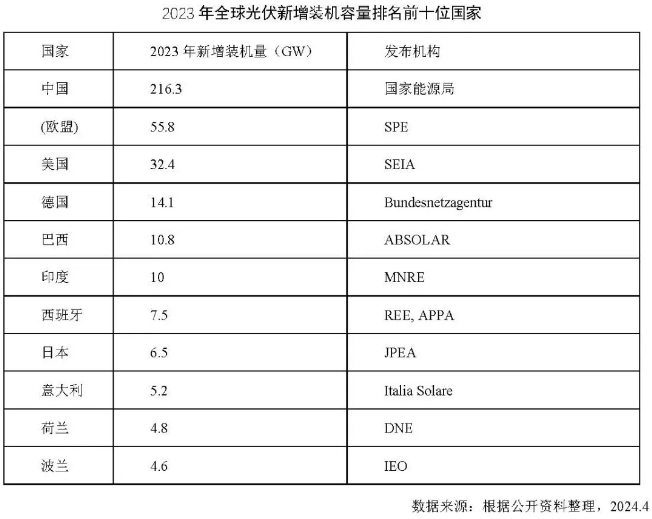Development of global photovoltaic application market
1. Global in 2023photovoltaic applicationsoverall market situation
In 2023, global photovoltaic capacity will be 390GW, a year-on-year increase of 69.6%, and the cumulative installed capacity will be approximately 1546GW. Global photovoltaic installed capacity will hit a new high in 2023.

In 2023, China will continue to maintain its leading position in the global new installed capacity market, with an annual increase of 216.3GW of installed capacity on the exchange side, a record high. The new photovoltaic installed capacity has ranked first in the world for 11 consecutive years since 2013. In 2023, China's new photovoltaic installed capacity will exceed half of the world's new installed capacity, and the cumulative installed capacity will account for nearly 40% of the world's total.

2. Policy changes in major photovoltaic markets
(1) Develop local photovoltaics in the entire industry chain in the United States
In recent years, the United States has passed and issued a number of blockbuster bills, including the Infrastructure Investment and Jobs Act, the Buy American Act, and the Inflation Reduction Act, etc., attempting to promote the development of local photovoltaics by strengthening investment in R & D and innovation, strengthening the competitiveness of local manufacturing, and improving market investment enthusiasm, accelerating project development and utilization. Stimulated by relevant policies, the installed capacity of solar power in the United States continues to grow. According to statistics from the American Photovoltaic Industry Association (SEIA), the cumulative installed capacity of photovoltaic power in the United States will reach 179GW in 2023, with an average growth of 22% in the past ten years.
On the manufacturing side, the Inflation Reduction Act has also stimulated the development of local photovoltaic manufacturing. The production capacity of local modules has increased from 8GW in 2022 to more than 12GW currently. Since 2023, Jingao Technology, LONGi Green Energy, Jingke Energy, TCL Zhonghuan, Ates, Trina Solar and other companies have accelerated the construction of overseas production capacity and integrated into the regional industrial chain system. They have successively announced investment in the construction of photovoltaic manufacturing projects in the United States. By 2026, U.S. domestic component production capacity is expected to reach 123GW. However, there are various difficulties and challenges between planning and actual implementation, and then to the implementation of the project. Due to various difficulties such as financing, manufacturing experience, market competition, technology and raw materials, it is difficult to implement most new production capacity.
(2) EU supports photovoltaic manufacturing and strengthens supply chain resilience
In 2022, REPowerEU plans to further increase the target of renewable energy consumption to 45%, and the installed capacity of renewable energy will reach 1236GW. Among them, the "EU Solar Strategy", as part of this plan, sets a development goal of adding photovoltaic installed capacity to exceed 320GW by 2025 and 600GW by 2030. On March 16, 2023, the European Commission proposed the "Net Zero Industries Act" and the "Critical Raw Materials Act" bills, stipulating that the EU's local zero-carbon technology production capacity must reach 40% by 2030. At the same time, in order to strengthen the EU's ability to extract, process and recycle strategic raw materials, it is also stipulated that 10% of strategic raw materials will be mined within the EU in 2030, and the other 15% of the EU's key raw materials will strictly come from recycling. From the perspective of policy measures, they mainly include measures such as optimizing the project licensing process, providing financial support, strengthening talent supply, improving the transparency of product information, and implementing carbon tariffs and industrial subsidies.
(3) India strives to promote the development of domestic photovoltaic industry
India officially updated its "nationally determined contribution" based on the Paris Climate Agreement in 2022, promising to reduce the carbon intensity of its GDP by 45% from 2005 levels by 2030; With the help of technology transfer and low-cost international financing including the Green Climate Fund (GCF), by 2030, the cumulative installed power capacity of non-fossil energy sources will reach 50% of the total capacity, and the installed capacity of non-fossil energy sources will reach 500GW, of which solar energy will provide goals such as 280GW. At the same time, the Indian government has also adopted some protectionist policies on the photovoltaic industry. The first one is the Basic Tariff (BCD). Starting from April 1, 2022, the government will impose a basic tariff of 25% on imported solar photovoltaic cells. A basic tariff of 40% is imposed on imported solar photovoltaic modules. On March 29, 2024, India's New and Renewable Energy Sector (MNRE) announced that the ALMM list of solar photovoltaic modules should take effect from April 1, 2024.







